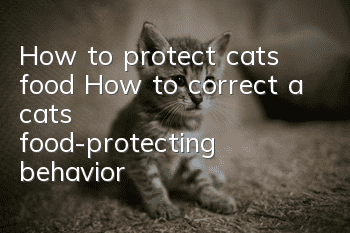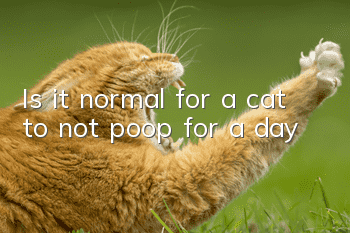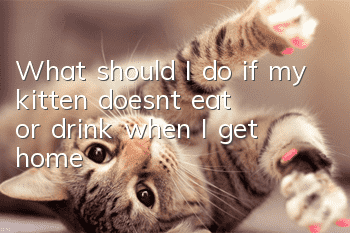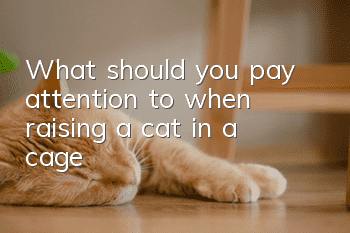How to protect cats’ food? How to correct a cat’s food-protecting behavior?

When you were a child, when the children next door cast their eyes on the candy in your hand, you would instinctively protect your delicious food.
When I grew up and raised cats, I found that some cats are like children. Once they have their own food, they will tightly protect it and prevent other cats from taking it away.
It turns out that cats also have food-protecting behaviors. Their reasons for protecting food are not single. However, the behavior of protecting food may affect the cat's life and become one of the habits that the cat will follow throughout his life. Is cats guarding food just because they are too hungry, the food is too delicious, or the cat is territorial? In fact, there are more than just cats guarding food. There are different forms of food guarding in cats, and these forms carry different reasons.
Some signs of cats’ food-protective behavior
Some signs of a cat’s food-protective behavior are subtle, so sometimes we may not realize what the cat is doing. Cats guarding their food bowls or keeping other cats out of the room they live in is a common intimidation tactic used by cats trying to protect and claim food. Some cats will even drive other cats away from their food bowls or grab other cats' food bowls.
The behavior of cats guarding food is more common among cats who are insecure. They will growl in their throats to warn other cats not to come over and compete with them for food. If this cat has been eaten by other animals or cats before, If they have been bullied, their behavior of protecting food will be stronger.
Some cats will jump on the owner’s table to find food. In fact, this is also a sign of cats protecting food. However, this situation is relatively hidden. Some owners do not pay too much attention to it and do not feel that this is a cat protecting food. Some owners He even gives the cat some food. However, the cat’s behavior of jumping on the dining table must be stopped and corrected promptly, and the urge to feed the cat must be resisted. Otherwise, you may not be able to enjoy your own meal in the future, because cats may come to harass and beg for food as soon as they see their owner dining. They will regard the owner’s dining table as their own.
Several common reasons for cats’ food-protecting behavior
1. When kittens are abandoned when they are young or separated from their mother cats prematurely, without proper weaning, they will be more likely to develop food-protecting behaviors.
2. The behavior of cats protecting food can also occur in cats who are forced to live outdoors. In order to find scarce food and survive the pressure of life, they must do this. The food-protecting behavior of pet cats usually occurs when there are one or more cats in the house, and then a new cat is adopted. Because when aboriginal cats interact with new cats, both parties will use their own self-defense instincts, which also includes food-protecting behaviors.
3. Improper feedingFood can also cause cats to guard their food. For example, giving your cat only a small amount of food every day or feeding your cat only once a day will trigger the cat's desire to protect food. In the wild environment, apart from sleeping, cats are either hunting or on the way to hunt. Their state is to eat small meals frequently, so eating only once a day may break the cat's natural instinct.
4. In addition, health problems can also cause cats to exhibit food-protecting behaviors. Therefore, if the cat suddenly exhibits food-protecting behavior, and you are not sure what is wrong with the cat, then the editor recommends that you take the cat for a physical examination to ensure that the cat’s behavior is not caused by a health problem.
Some tips on correcting cats’ food-protecting behavior
There are many ways to correct cats’ food-protecting behavior, but these require owners to spend time and patience to actively guide and train cats.
1. The simplest and crudest way is to separate the cats when they are eating. However, if you use a feeder to feed the cat and let the cat eat freely, then this method may not be very effective. If this is the case, the editor recommends that you add a feeder in a separate room, which can reduce the number of cats fighting for the feeder and protecting food.
2. If cats are fed in the same room, and the cats have not had the habit of sharing dinner plates before, it is recommended to allocate an independent dinner plate to each cat. Then supervise the cats while they are eating to ensure that the cats eat in their own special plates. If the cats behave badly, they will be stopped and corrected immediately.
3. Playing interactive games with cats and rewarding them with delicious food can also help reduce cats’ food-protecting behavior. Cat teasers or other toys can be used to interact and play with cats to ensure that cats do not show unfriendly behavior towards other cats during play. If the cats do not fight during the game, then after the game is over, give each cat some food rewards and praise them. The cats will establish a positive bond during this interactive game and gradually let down their guard against each other.
- What causes cats to have bad mouth?
- How many placentas do cats have when giving birth to kittens? Why do female cats eat their placentas?
- Is the cat playing when he keeps rolling on the ground?
- What should I do if my cat won’t let me cuddle? How to hold a cat in the correct posture?
- How to deworm cats? How to deworm cats?
- Should I give my cat tap water or filtered water?
- What kind of cat is the Ragdoll cross?
- How to stimulate defecation in kittens?
- Why do I always feel itchy if I have a cat?
- How to train a Balinese cat to sleep in a cat's nest How to train a Balinese cat to sleep in a cat's nest



